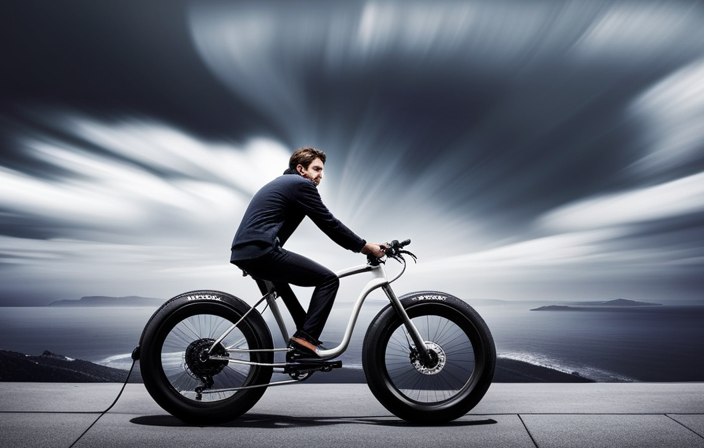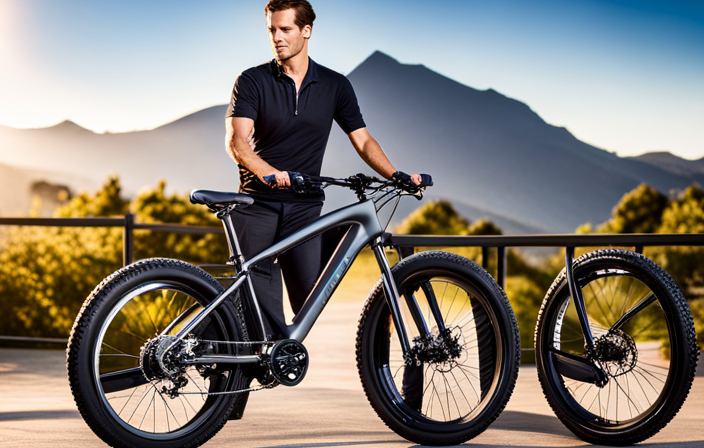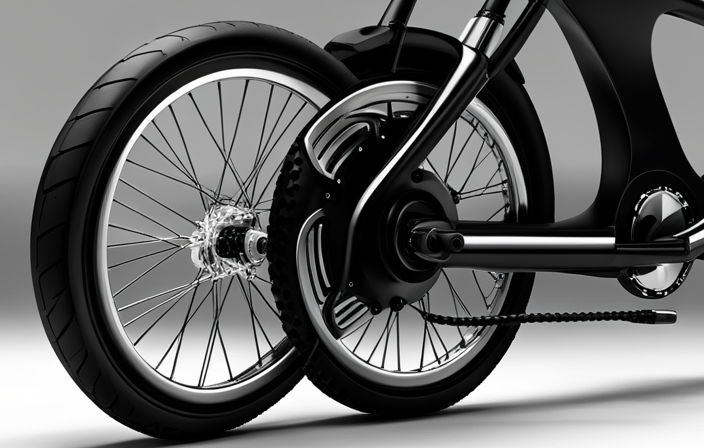Did you know that the demand for electric bikes has skyrocketed by 145% in the past year? It’s no surprise – these innovative vehicles offer a convenient and eco-friendly alternative to traditional biking.
But have you ever wondered how hard it is to pedal an electric bike? In this article, I will delve into the intricacies of electric bike pedaling, exploring the factors that affect its difficulty and providing tips to help you find the perfect balance between effort and enjoyment.
So, hop on and let’s dive into the world of electric bike pedaling!
Key Takeaways
- Electric bikes provide a convenient and eco-friendly alternative to traditional biking, with a 145% increase in demand in the past year.
- Pedal-assist e-bikes optimize pedaling effort with electric motor assistance, making uphill climbs easier and providing a boost when starting to pedal.
- The difficulty of pedaling an e-bike is influenced by factors such as terrain, rider and e-bike weight, and level of assistance.
- Pedaling an electric bike offers fitness benefits, improves cardiovascular health and leg muscles, and allows for faster and farther rides while still requiring some effort.
Understanding the Basics of Electric Bikes
You’ll find it helpful to understand the basics of electric bikes. As someone who has been riding electric bikes for years, I can confidently say that they are a game-changer.
One of the key aspects of owning an electric bike is ensuring proper maintenance. Just like any other vehicle, electric bikes require regular check-ups and servicing to keep them running smoothly. It’s important to pay attention to the battery, as it is the heart of your electric bike.
Choosing the right e bike battery is crucial, as it affects both the performance and range of your bike. Make sure to consider factors such as capacity, voltage, and weight when selecting a battery.
Now, let’s dive into the difference between pedal-assist and throttle-controlled e-bikes.
The Difference Between Pedal-Assist and Throttle-Controlled E-Bikes
Contrasting pedal-assist and throttle-controlled e-bikes, the former requires more physical effort while the latter demands less. Pedal-assist bikes, equipped with cadence or torque sensors, provide assistance only when the rider is actively pedaling. These sensors monitor the rotation of the pedals and adjust the motor’s power output accordingly. On the other hand, throttle-controlled e-bikes allow the rider to activate the motor with a simple twist of the throttle, similar to a motorcycle. This means that no pedaling is necessary to maintain speed, making it easier for those who may have physical limitations or prefer a more relaxed ride. However, throttle-controlled e-bikes can drain the battery faster and may be less efficient in terms of range. Moving on to the next section, we’ll explore how electric motors assist with pedaling effort.
How Electric Motors Assist with Pedaling Effort
Pedal-assist and throttle-controlled e-bikes provide different levels of assistance to riders.
When it comes to pedal-assist e-bikes, the electric motor technology is designed to optimize the performance of pedaling effort. The motor kicks in when the rider starts pedaling, providing a boost that makes it easier to pedal. This assistance can be adjusted to different levels, allowing riders to choose the amount of help they need. The motor’s power is transmitted to the bike’s drivetrain, amplifying the rider’s pedaling force. This means that even when faced with challenging terrains or uphill climbs, the electric motor ensures a smooth and effortless ride. It truly feels like having a strong tailwind pushing you forward. So, with the right pedal-assist setting, pedaling an electric bike becomes a joyous and exhilarating experience.
Transitioning into the next section, let’s explore the factors that affect the difficulty of pedaling an e-bike.
Factors that Affect the Difficulty of Pedaling an E-Bike
Navigating the terrain on an e-bike can feel effortless or challenging depending on various factors. Factors such as the terrain, the weight of the rider and the e-bike, and the level of assistance provided by the electric motor can all impact the difficulty of pedaling an e-bike. For example, steep hills or rough off-road trails can make pedaling more difficult, while flat roads or smooth paths can make it feel easier. Additionally, a heavier rider or a heavier e-bike can require more effort to pedal. The level of assistance provided by the electric motor can also affect the difficulty, as some e-bikes offer different levels of assistance that can be adjusted to match the rider’s preferred effort level. Overall, these factors can greatly impact the difficulty of pedaling an e-bike and should be considered when choosing an e-bike for different terrains and riding conditions.
| Factors Affecting Pedaling Difficulty | Impact of Terrain on E-Bike Pedaling |
|---|---|
| Weight of rider | Steep hills |
| Weight of e-bike | Rough off-road trails |
| Level of assistance | Flat roads |
In the next section, we will compare the effort required on electric bikes and regular bikes, highlighting the advantages and differences between the two.
Comparing the Effort Required on Electric Bikes and Regular Bikes
When comparing the effort needed on e-bikes and regular bikes, there are noticeable differences in required exertion.
-
Effort Comparison: Electric bikes require less physical effort compared to regular bikes. The motor assists in pedaling, reducing the strain on your muscles and making it easier to cover longer distances without feeling exhausted.
-
Muscle Engagement: While electric bikes still require some pedaling, the level of muscle engagement is lower than on regular bikes. This means that you can enjoy a leisurely ride without putting as much strain on your legs and overall body.
-
Enjoyable Experience: The reduced effort on electric bikes allows riders to have a more enjoyable experience. You can effortlessly glide through different terrains, including uphill climbs, and still feel refreshed at the end of your ride.
Transition: Now that we’ve discussed the effort comparison between electric bikes and regular bikes, let’s explore the benefits of pedaling an electric bike.
The Benefits of Pedaling an Electric Bike
You’ll experience a range of advantages by using the motor-assisted feature on an e-bike. Not only does it make pedaling easier, but it also opens up a world of possibilities for cyclists of all skill levels. Take a look at the table below to see some of the benefits of pedaling an electric bike.
| Benefits | Advantages |
|---|---|
| Less effort required | Pedaling becomes effortless, allowing you to go faster and farther with ease. |
| Increased range | The motor assistance helps you conquer hills and ride longer distances without getting tired. |
| Fitness benefits | Pedaling an e-bike still provides a good amount of exercise, helping you improve your cardiovascular health and strengthen your leg muscles. |
With these benefits in mind, it’s clear that pedaling an electric bike can greatly enhance your cycling experience. So let’s dive into some tips for optimal pedaling efficiency on an e-bike, ensuring you get the most out of your ride.
Tips for Optimal Pedaling Efficiency on an E-Bike
To maximize your efficiency while riding an e-bike, it’s important to focus on your pedaling technique. One key aspect to consider is your optimal cadence, or the speed at which you pedal. Finding the right cadence will ensure that you are not exerting too much energy or straining your muscles. Generally, a cadence of 80-100 revolutions per minute (rpm) is recommended for most riders.
Additionally, proper body positioning plays a crucial role in pedaling efficiency. Keeping your back straight, shoulders relaxed, and knees aligned with the bike will help you maintain a steady and efficient pedaling motion.
By paying attention to these factors, you can make the most out of your e-bike experience and enjoy a smoother and more enjoyable ride.
Now, let’s delve into understanding the role of gears on electric bikes.
Understanding the Role of Gears on Electric Bikes
Understanding how gears work on an e-bike can greatly enhance your riding experience. Gears play a crucial role in determining how hard or easy it is to pedal an electric bike. By adjusting the gears, you can find the perfect balance between power and effort.
The role of cadence on electric bikes is important to consider when using gears. Cadence refers to how fast you pedal, and it can affect your riding experience. Higher cadence can provide a smoother and more efficient ride, while lower cadence can offer more power and control. Gears allow you to adjust your cadence to match your desired level of effort and power output.
Using gears on an electric bike has both pros and cons. On the positive side, gears can make pedaling easier, especially when going uphill or against strong headwinds. They also allow you to maintain a consistent speed and reduce fatigue. However, using gears may decrease the range of your e-bike and consume more battery power.
Incorporating gears into your riding technique can make a significant difference in your overall enjoyment and performance on an electric bike. Now that we understand the role of gears, let’s explore how to adjust power settings for a comfortable pedaling experience.
How to Adjust Power Settings for a Comfortable Pedaling Experience
Adjusting power settings can help you achieve a more comfortable riding experience on your e-bike. It’s important to optimize the power output to find the right pedal assist level for your needs.
Here are a few tips to help you adjust the power settings for a smoother ride:
-
Experiment with different pedal assist levels: Start with a lower level and gradually increase it until you find the one that feels most comfortable for you.
-
Pay attention to your cadence: Adjust the power output to match your preferred pedaling speed. This will ensure a more natural and effortless riding experience.
-
Consider the terrain: If you’re riding on hilly or challenging terrain, increase the power output to make pedaling easier.
By fine-tuning the power settings, you can enjoy a comfortable pedaling experience on your e-bike.
Now, let’s explore some common myths and misconceptions about pedaling e-bikes.
Common Myths and Misconceptions about Pedaling E-Bikes
There are many common myths and misconceptions surrounding e-bike pedaling. One of the most prevalent misconceptions is that you don’t have to pedal at all on an electric bike. While it’s true that e-bikes have a motor that provides assistance, pedaling is still necessary for an enjoyable and efficient ride. Another misconception is that e-bikes are only for lazy or unfit individuals. In reality, e-bikes can be used by people of all fitness levels and can actually encourage physical activity. To debunk these misconceptions and shed light on the truth, here is a comparison table:
| Myth | Fact |
|---|---|
| E-bikes don’t require pedaling | E-bikes still require pedaling for optimal performance and efficiency |
| E-bikes are only for lazy people | E-bikes can be used by people of all fitness levels and encourage physical activity |
These common misconceptions should not deter you from considering an e-bike. In the next section, we will explore personal experiences and testimonials from e-bike riders, which will further showcase the benefits and joys of pedaling an electric bike.
Personal Experiences and Testimonials from E-Bike Riders
Many e-bike riders share their personal experiences and testimonials, highlighting the joys and benefits of using an electric bicycle.
-
E-bike riders’ experiences with steep uphill pedaling: One rider mentioned how the pedal assist feature made tackling steep uphill climbs a breeze. Another rider shared how they were able to conquer challenging terrains that they previously thought were impossible to ride on.
-
Testimonials on the impact of pedal assist on fitness levels: Many riders have noticed a significant improvement in their fitness levels since using an e-bike. They found that the pedal assist feature allowed them to push themselves further and engage in longer rides, ultimately leading to better cardiovascular health and increased stamina.
-
Increased enjoyment and freedom: Riders spoke about the sheer joy and freedom they experienced while riding an e-bike. The pedal assist feature provided them with the perfect balance of exercise and assistance, allowing them to explore new places and enjoy the ride without feeling exhausted.
-
Enhanced overall biking experience: E-bike riders emphasized how the electric assistance made biking more accessible and enjoyable for people of all fitness levels. It removed the barriers that often discourage people from cycling and opened up a whole new world of possibilities.
With these incredible experiences and testimonials in mind, let’s now transition to the next section about choosing the right electric bike for your needs and fitness level.
Choosing the Right Electric Bike for Your Needs and Fitness Level
To find the perfect e-bike for your needs and fitness level, you should consider factors such as your desired riding style, terrain preferences, and the range and power of the motor. Choosing the right electric bike for your fitness level is crucial because it ensures that you can pedal comfortably and enjoy your rides to the fullest. Understanding the benefits of pedaling an e-bike is also important. It allows you to engage in physical activity and improve your fitness while still getting assistance from the electric motor when needed.
Here is a table to help you compare different e-bikes based on their features and specifications:
| Feature | Description |
|---|---|
| Riding Style | Choose between city, mountain, or hybrid bikes |
| Terrain | Consider whether you’ll be riding on roads or trails |
| Motor Power | Look for high wattage for more assistance |
By choosing an e-bike that aligns with your fitness level and preferences, you can have a fun and fulfilling riding experience. In the next section, we will discuss maintenance and care tips for e-bike pedals and drivetrain, ensuring that your e-bike remains in top condition.
Maintenance and Care Tips for E-Bike Pedals and Drivetrain
Make sure you regularly clean and lubricate your e-bike pedals and drivetrain to keep them functioning smoothly and extend their lifespan. Here are some maintenance techniques and troubleshooting tips to help you with that:
- Clean the pedals and drivetrain with a degreaser and a brush to remove any dirt or grime that may accumulate over time.
- Apply a high-quality lubricant to the chain, cassette, and derailleur pulleys to ensure smooth shifting and minimize wear.
- Check the tension of the chain regularly and adjust it if necessary. A loose chain can lead to poor performance and increased wear.
- Inspect the pedals for any signs of damage or wear, such as loose bearings or worn-out cleats. Replace them if needed to avoid any safety issues.
By following these maintenance techniques and troubleshooting tips, you can ensure that your e-bike pedals and drivetrain are always in top shape.
Now let’s move on to the next section about legal and safety considerations for e-bike riders.
Legal and Safety Considerations for E-Bike Riders
Take into account the legal and safety guidelines for e-bike riders to ensure a safe and enjoyable riding experience.
When riding an electric bike, it is crucial to wear protective gear such as a helmet, knee pads, and elbow pads. This gear can greatly reduce the risk of injuries in case of accidents or falls.
Additionally, it is important to familiarize yourself with the rules and regulations for e-bike riders on public roads and trails. Different areas may have specific speed limits, age restrictions, or designated bike lanes for e-bikes.
By following these guidelines, you can ensure the safety of yourself and others while enjoying your e-bike rides. With the proper knowledge and adherence to these rules, you can have a worry-free and exhilarating experience on your electric bike.
Transitioning into the next section, understanding how electric motors assist with pedaling effort and adjusting power settings can help you find the perfect balance of comfort and exercise while enjoying the benefits of an e-bike.
Conclusion: Pedaling an electric bike can be as easy or challenging as you want it to be, depending on various factors. Understanding how electric motors assist with pedaling effort and adjusting power settings can help you find the perfect balance of comfort and exercise while enjoying the benefits of an e-bike
Now that we’ve discussed the legal and safety considerations for e-bike riders, let’s delve into the conclusion.
Pedaling an electric bike can be as easy or challenging as you want it to be. It all depends on various factors such as your desired level of exertion and the assistance provided by the electric motor.
As someone who has experienced the joy of riding an electric bike, I can attest to the efficiency of these machines. Electric motors seamlessly assist with pedaling effort, making uphill climbs and long distances more manageable.
However, it’s important to remember that pedaling an e-bike still offers numerous health benefits. You can choose to adjust the power settings to find the perfect balance between comfort and exercise.
So, hop on an e-bike and experience the best of both worlds – the convenience of electric assistance and the satisfaction of a good workout.
Frequently Asked Questions
Are electric bikes more difficult to pedal than regular bikes?
Electric bikes require less physical exertion and cause less muscle fatigue compared to regular bikes. Pedaling an electric bike is easier due to the assistance provided by the motor, making it a more enjoyable and less strenuous experience.
Can I adjust the level of assistance provided by the electric motor?
Absolutely! You have complete control over the level of assistance provided by the electric motor. It’s like having a personalized wingman who adjusts their support based on your needs. Just keep in mind that adjusting the assistance level can impact the battery life.
What factors affect the difficulty of pedaling an e-bike?
Terrain challenges and battery level greatly impact the difficulty of pedaling an e-bike. Uphill climbs and rough surfaces can make it harder, while a low battery can reduce the assistance provided by the motor, requiring more effort.
Is it possible to pedal an e-bike without any assistance from the electric motor?
Yes, it is possible to pedal an e-bike without assistance from the electric motor. By using proper pedaling technique and building up endurance, muscle fatigue can be reduced, allowing for a more enjoyable and efficient ride.
How do electric bikes compare in terms of effort required to pedal compared to regular bikes?
Pedaling an electric bike requires less effort compared to regular bikes. The electric motor provides assistance, making it easier to conquer hills and ride longer distances. It’s like having a trusted sidekick that amplifies your pedaling power.
Conclusion
Pedaling an electric bike can be an exhilarating and effortless experience, tailored to your preferences and fitness level. With the help of electric motors, you can conquer hills with ease and enjoy a smooth ride.
Did you know that electric bikes can reach speeds of up to 20 mph? This statistic showcases the incredible power and speed that these bikes offer.
Whether you’re looking for a leisurely cruise or a challenging workout, an electric bike is a fantastic option that combines convenience and fitness.
So hop on, feel the wind in your hair, and embrace the joy of riding!









